 W
WMarco Berlinghieri was an Italian medieval miniature painter and book illuminator who executed an illuminated Bible, finished in 1250. He was the son of Berlinghiero Berlinghieri and the brother of Barone and Bonaventura Berlinghieri.
 W
WBerlinghiero Berlinghieri, also known as Berlinghiero of Lucca, was an Italian painter of the early thirteenth century. He was the father of the painters Barone Berlinghieri, Bonaventura Berlinghieri, and Marco Berlinghieri.
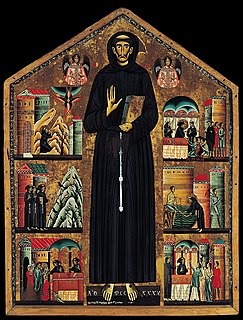 W
WBonaventura Berlinghieri was an Italian painter from Lucca, Italy, of the Gothic period. He was son of painter Berlinghiero Berlinghieri and brother of Barone and Marco Berlinghieri.
 W
WThe Master of the Bigallo Crucifix (fl.1215/20-1265) was an Italian religious artist who ran one of the first fully organized workshops before Cimabue. His notname comes from a crucifix on wood which is displayed at the Museo del Bigallo in Florence.
 W
WSegna di Bonaventura, also known as Segna de Bonaventura, and as Segna di Buonaventura, was an Italian painter of the Sienese School. He was active from about 1298 to 1331. In 1306 he painted a panel for the office of the Biccherna in the Palazzo Pubblico in Siena. In 1317 he painted an altar panel for the convent of Lecceto. In 1319 he repaired a figure of the Virgin in the Palazzo Pubblico. In 1321 he painted a panel for the Palazzo Pubblico. Segna di Bonaventura’s sons Niccolò di Segna and Francesco di Segna di Bonaventura were also painters of the Sienese School
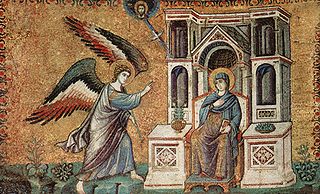 W
WPietro Cavallini was an Italian painter and mosaic designer working during the late Middle Ages.
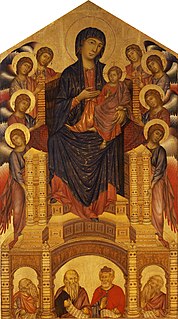 W
WCimabue, also known as Cenni di Pepo or Cenni di Pepi, was an Italian painter and designer of mosaics from Florence.
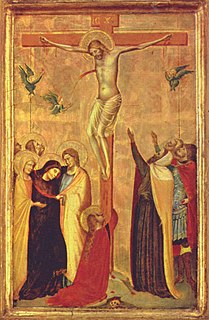 W
WBernardo Daddi was an early Italian Renaissance painter and the leading painter of Florence of his generation. He was one of the artists who contributed to the revolutionary art of the Renaissance, which broke away from the conventions of the preceding generation of Gothic artists, by creating compositions which aimed to achieve a more realistic representation of reality. He was particularly successful with his small-scale works and contributed to the development of the portable altarpiece, a format that subsequently gained great popularity.
 W
WMontano d'Arezzo flourished about the end of the 13th, and the commencement of the 14th, centuries. In 1305 he painted two chapels of the Castel Nuovo, and in 1306 two chapels of the Castel del Uovo, at Naples. He was a favourite of King Robert, who knighted him in 1310. The chapel of the Monastery of Monte Vergine, near Avellino, has a picture of the Madonna said to be by him. The Dormitory dei Giovannetti of the Seminario Urhano, at Naples, has a half-length picture of a Bishop by him. The dates of Montano d'Arezzo's birth and death are no longer known, and little can now be found belonging to this artist.
 W
WDuccio di Buoninsegna was an Italian painter active in Siena, Tuscany, in the late 13th and early 14th century. He was hired throughout his life to complete many important works in government and religious buildings around Italy. Duccio is considered one of the greatest Italian painters of the Middle Ages, and is credited with creating the painting styles of Trecento and the Sienese school. He also contributed significantly to the Sienese Gothic style.
 W
WThe Master of Saint Francis was an anonymous Italian painter, perhaps of Pisan origin though probably trained in Umbria, working between 1250–1280. His work embodies an important aspect of the contact between Italian and Byzantine art of this period.
 W
WGaddo Gaddi was a painter and mosaicist of Florence in a gothic art style. Almost no works survive. He was the father of Taddeo Gaddi. He completed mosaics on facade of Santa Maria Maggiore in Rome. The "Coronation of the Virgin" mosaic over the inside door of Florence Cathedral, dated 1307, is also attributed to Gaddo Gaddi.
 W
WGiotto di Bondone, known mononymously as Giotto and Latinised as Giottus, was an Italian painter and architect from Florence during the Late Middle Ages. He worked during the Gothic/Proto-Renaissance period. Giotto's contemporary, the banker and chronicler Giovanni Villani, wrote that Giotto was "the most sovereign master of painting in his time, who drew all his figures and their postures according to nature" and of his publicly recognized "talent and excellence". Giorgio Vasari described Giotto as making a decisive break with the prevalent Byzantine style and as initiating "the great art of painting as we know it today, introducing the technique of drawing accurately from life, which had been neglected for more than two hundred years".
 W
WAmong the paintings attributed to Giovanni da Rimini are two panels from a former diptych, dated to 1300–1305, of which the left wing is in the collection of the National Gallery, London, and the right that of the Galleria Nazionale d'Arte Antica, Palazzo Barberini, Rome.
 W
WGiunta Pisano was an Italian painter. He is the earliest Italian painter whose name is found inscribed on an extant work. He is best known for his crucifixes.
 W
WGuido of Siena, was an Italian painter, active during the 13th-century in Siena, and painting in a Byzantine style.
 W
WThe Isaac Master was an Italian Gothic painter active in the decoration of the Basilica of San Francesco d'Assisi in Assisi at the end of the thirteenth century.
 W
WAmbrogio Lorenzetti or Ambruogio Laurati was an Italian painter of the Sienese school. He was active from approximately 1317 to 1348. He painted The Allegory of Good and Bad Government in the Sala dei Nove in Siena's Palazzo Pubblico. His elder brother was the painter Pietro Lorenzetti.
 W
WPietro Lorenzetti or Pietro Laurati was an Italian painter, active between c.1306 and 1345. Together with his younger brother Ambrogio, he introduced naturalism into Sienese art. In their artistry and experiments with three-dimensional and spatial arrangements, the brothers foreshadowed the art of the Renaissance.
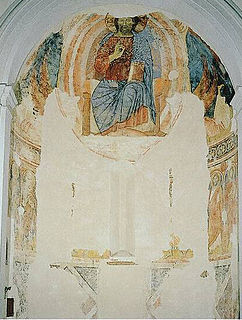 W
WManfredino di Alberto, also known as Manfredino d'Alberto or Manfredino da Pistoia was an Italian painters active during the 13th-century in Pistoia and Genoa.
 W
WCoppo di Marcovaldo was a Florentine painter active in the middle of the thirteenth century, whose fusion of both the Italian and Byzantine styles had great influence on generations of Italian artists.
 W
WMargarito or Margaritone d'Arezzo was an Italian painter from Arezzo.
 W
WSimone Martini was an Italian painter born in Siena. He was a major figure in the development of early Italian painting and greatly influenced the development of the International Gothic style.
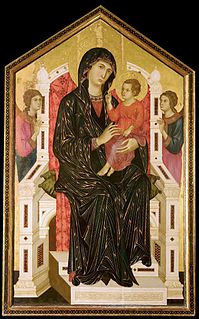 W
WThe Master of Badia a Isola was an Italian painter. His name is taken from a depiction of the Madonna and Child that hangs in the Badia dei Santi Salvatore e Cirino in Abbadia a Isola, located near Monteriggioni, a comune in the province of Siena; a number of other paintings by his hand are also believed to exist.
 W
WMaster of Città di Castello, in Italian, Maestro di Città di Castello, was an anonymous painter of Medieval art. Mason Perkins is responsible for his identification and naming in 1908, based on the styling from the Master preserved at the Pinacoteca comunale, Città di Castello, in Umbria.
 W
WThe Master of St Cecilia is the notname given to an Italian painter active circa 1290 to 1320 in Florence and its environs.
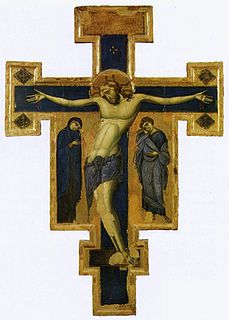 W
WThe Master of the Blue Crucifixes was an Italian artist active either in the region of Umbria or Emilia during the middle of the thirteenth century. He is associated with the Basilica of San Francesco d'Assisi, and may have been an assistant of Giunta Pisano, whose work his paintings resemble. A number of his works survive, mainly processional crucifixes, from which his name is derived.
 W
WThe Master of the Gubbio Cross was the name given to an Umbrian painter active between about 1285 and about 1320. He appears to have been familiar with the artists working at the Basilica of San Francesco d'Assisi, and some of his work bears a resemblance to that of Giunta Pisano.
 W
WThe Master of the Maddalena is an unnamed Florentine artist active in the second half of the 13th century. He is named after his best known work, Mary Magdalene with Eight Scenes from her Life. According to Miklos Boskovits, Grifo di Tancredi trained in this master's studio.
 W
WThe Master of the Treasury was an Italian painter working in the Byzantine style during the middle of the thirteenth century. A follower of Giunta Pisano, he is known from a painting in the treasury of the Basilica of San Francesco d'Assisi representing the titular saint and four of his posthumous miracles.
 W
WMeliore di Jacopo (fl.1255-1285) was a Medieval Italian painter from Florence.
 W
WDeodato Orlandi was an Italian painter who was active in Lucca and Pisa. His work marks the transition from the Italo-Byzantine painting of the 13th century to the Giotto-inspired style of the 14th century.
 W
WFilippo Rusuti, was an Italian painter, active in Rome between 1288 and 1297, and in Naples around 1320.
 W
WVigoroso da Siena was an Italian painter, known to be active 1270-1280. He was naturalized to Siena, Tuscany. A contemporary of Cimabue, his only documented work is a polyptych at the Galleria Nazionale of Perugia dated 1291.
 W
WDietisalvi di Speme was an Italian painter, who worked in Siena between 1250 and 1291. In his work he influenced and was influenced by Cimabue.
 W
WAndrea Tafi (1213–1294) was an Italian artist. He is probably best known for his work on the mosaics of the Baptistery in Florence, which were started in 1225 by Jacobus. His pupils included Buonamico Buffalmacco.
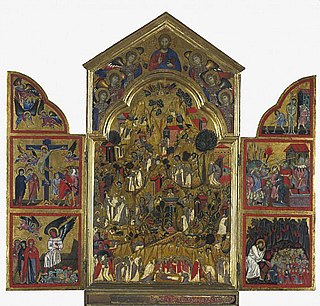 W
WGrifo di Tancredi was an Italian painter, likely born in Florence. Little biographical history is known for this painter, and one existing work, a tryptich at the National Gallery of Scotland, has been attributed to him on the basis of inscriptions. He was active in Volterra by 1271, and later in Florence. He was previously cited as the Master of San Gaggio.
 W
WUgolino di Tedice, was an Italian painter and the brother of Enrico di Tedice.